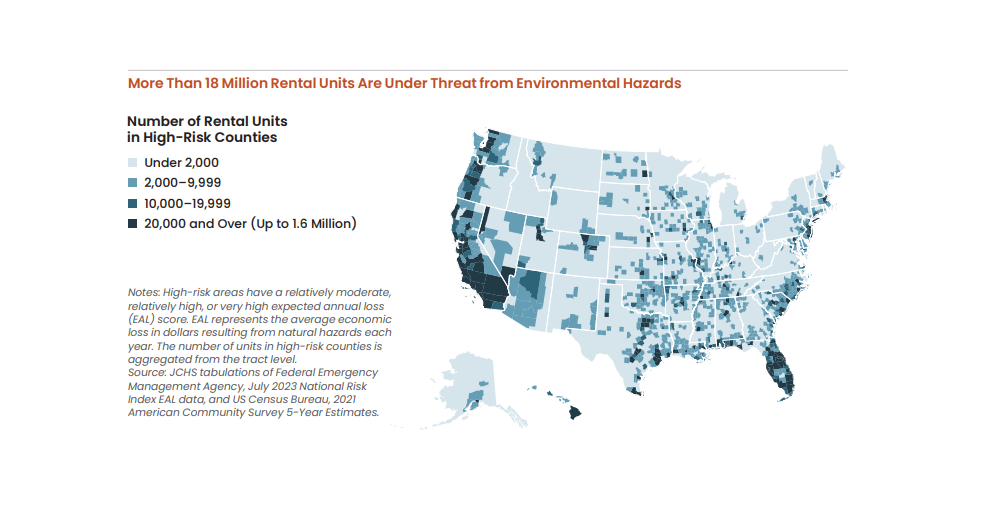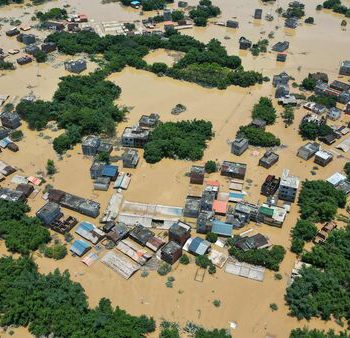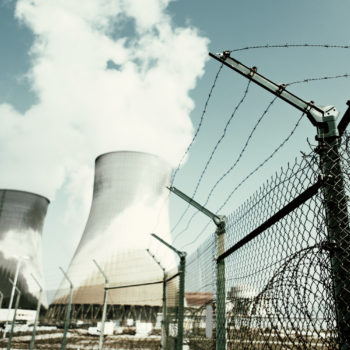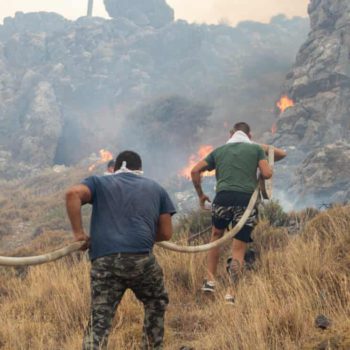|
|
As extreme weather events become increasingly common, the threat of climate hazards extends beyond companies to property owners and renters.
A recent study by Harvard University’s Joint Center for Housing Studies reveals that more than 18 million rental units across the United States are vulnerable to climate- and weather-related dangers.
Using data from the Federal Emergency Management Agency’s National Risk Index and the American Community Survey, the researchers identified which residential units are in the areas expected to experience annual economic losses from environmental hazards like wildfires, flooding, earthquakes, and hurricanes. They have found that:
-
- Nearly half of single-family rentals and a significant portion of units in multifamily buildings are in areas exposed to climate-related hazards.
-
- Manufactured housing units, comprising a substantial portion of the rental stock (52%) that includes mobile homes and RVs, face the highest risk, with over half located in areas prone to extreme weather.
Sophia Wedeen, a research analyst at the Joint Center for Housing Studies, highlights the alarming state of the rental housing stock, emphasizing that much of it is ill-prepared to withstand the increasing frequency and severity of environmental threats.
Vulnerability of Property Owners and Renters
The state of rental housing stocks is not the only cause for concern.
According to Jeremy Porter, head of climate implications research for nonprofit organization First Street Foundation, half of all properties in the US are at risk of flooding, yet their owners are unaware. This lack of awareness can lead to significant financial repercussions.
Property owners are left vulnerable to the financial burden of repairing flood damage without flood insurance. The costs can quickly escalate, ranging from minor repairs to substantial overhauls, depending on the severity of the flooding. For those unprepared, this could mean dipping into personal savings or even facing the harsh reality of foreclosure if the expenses become unmanageable.
Yet, with the steep cost and increasingly complex insurance coverage, many homeowners and renters take the risks. This is especially true for those renting in manufactured housing, low-rent or subsidized units, who often need more resources to relocate or protect themselves adequately. Porter emphasizes that vulnerable populations are disproportionately affected by climate hazards due to financial constraints, compounding the risks they face.
In the aftermath of natural disasters, assistance primarily benefits homeowners, leaving renters displaced and struggling to secure alternative housing.
Harvard’s study highlighted the critical need for proactive measures that focus on pre-disaster mitigation and adaptation efforts to minimize future threats, protect the increasingly scarce rental housing stock, and enhance the resilience of communities against environmental dangers. These strategies involve improving infrastructure to withstand extreme weather conditions, implementing flood defense systems, or adopting building codes that require more durable construction practices.
Such investments can help safeguard properties and occupants from immediate harm and stabilize long-term housing. Reducing the frequency and severity of damage from environmental hazards means less disruption for tenants and potentially lower insurance costs for property owners. Ultimately, this approach serves as a buffer that helps minimize the socioeconomic impacts of climate-related disasters, ensuring the availability of affordable housing and protecting residents from sudden financial distress.
Your Weekly Sustainability News!
By subscribing you agree to our Privacy Policy
What Property Owners and Renters Can Do
The data presented by NOAA’s National Centers for Environmental Information in 2023 is a stark reminder of the escalating challenge posed by weather and climate disasters.
With a reported 28 significant events causing nearly $93 billion in damages, it’s clear that these disasters’ frequency and financial impact are on an upward trajectory, underscoring the increasing toll these events are taking on the country.

Image Source: https://www.climate.gov/news-features/blogs/beyond-data/2023-historic-year-us-billion-dollar-weather-and-climate-disasters
The same report revealed a striking comparison: where the 1980s experienced a major disaster roughly every 82 days; the current climate sees such events occurring approximately every 18 days from 2018 to 2022. This drastic reduction in recovery time significantly strains resources, making it increasingly difficult for communities to bounce back and adequately prepare for the next challenge.
In the face of these escalating natural hazards brought by climate change, property owners and renters must take proactive steps toward preparedness to safeguard themselves and their assets against the impact of climate hazards. Below are some practical steps that can be taken:
| Action | Property Owners | Renters |
|---|---|---|
| 1. Conduct a Risk Assessment | Evaluate the property’s susceptibility to climate hazards like floods, wildfires, and earthquakes. | Ask landlords about any risk assessments done for your dwelling. Knowing potential dangers can help tailor readiness plans. |
| 2. Invest in Resilience Measures | Strengthen properties by installing storm shutters, elevating structures in flood zones, or using fire-resistant plants. | Encourage landlords to implement protective measures against climate threats. Suggestions might include improving window security or ensuring detectors are installed and functional. |
| 3. Secure Insurance Coverage | Review insurance plans carefully to confirm they cover climate-related incidents. Floods and earthquakes often need separate policies. | Renter’s insurance is crucial for protecting personal property against disaster damage. Understand what your policy covers and consider additional insurance if necessary. |
| 4. Develop an Emergency Preparedness Plan | Create comprehensive emergency plans for tenants, detailing evacuation routes and emergency contacts. Clear communication of these procedures is crucial. | Be well-acquainted with emergency protocols provided by property management. Keep essential supplies readily available, including food, water, and medical kits. |
| 5. Stay Informed and Remain Vigilant | Everyone should closely follow local weather forecasts and heed official warnings. Emergency alerts can provide critical information during crises. | Regular maintenance checks are essential for identifying potential issues early on. Property owners should address maintenance concerns promptly to avoid exacerbations. |
Conclusion
As climate change continues to escalate the frequency and severity of extreme weather events, empowering property owners and renters with knowledge and resources to mitigate risks is paramount. Through proactive measures and informed decision-making, property owners and renters can better protect themselves in an increasingly unpredictable environment.












